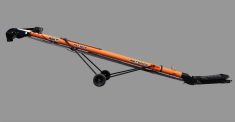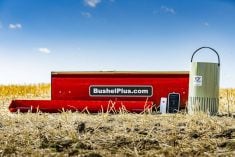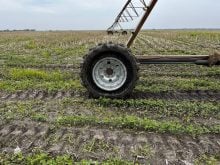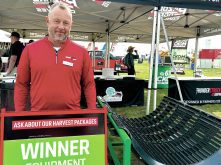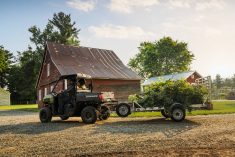Speaking at an event in Brandon in March, Joel McDonald, an engineer working for PAMI (Prairie Agricultural Machinery Institute), gave producers the benefit of his years of experience in evaluating combine performance.

“This is a quote I like to use about managing your harvest, and your combine,” he told the crowd. “‘A combine is a highly complex factory with a continually changing feed stock.’ That’s no big deal, except it’s expected to have a highly consistent, high-quality output at all times.”
It’s those changing conditions that make keeping a combine performing to its maximum potential no easy thing. Crop conditions naturally change at different places in the field. Add variable weather conditions to that and things get even more complicated.
- Read more: Monitoring your harvest loss
“I don’t have magic combine settings for you,” he continued. “That’s just like the complex factory. There are so many different parameters that are changing all the time that there are no magic settings. There are good places to start, and you have to adjust from there.”
Read Also

Claas brings 1000 Series SP forage harvesters to Canada
In mid-August, Claas unveiled its new line of Jaguar forage harvesters at an event in Visalia, California, deep in the heart of that state’s dairy region.
So where are those good places to start and what should farmers change? Is it just a matter of slowing down ground speed to cure all the problems?
How slow should I go?
“I like to talk in terms of grain feed rate over ground speed,” said McDonald. “It’s a lot more accurate. I really encourage farmers to think in terms of bushels per hour. That is the most consistent metric you have available to relate this year to next, and one crop to another.
“Ground speed is only a good metric if our crop is perfectly uniform. And it never is. What we can do is talk in terms of grain feed rate. The amount of MOG (material other than grain) compared to grain is somewhat consistent, or is relatable anyway.”
It’s the amount of material going up the feeder house that really influences the amount of grain loss. As the amount of MOG going into the combine increases, it tends to carry more kernels out the back with it. But losses will also be higher if too little material is flowing through.
“You can see at a low rate, the loss is a little bit higher,” he explained. “When the feed rate is higher, it lowers down a little, then it starts to go up. The shape of the curve can vary in how quickly it rises. Sometimes there is a little bit more of a flat spot in the middle of it. But once you’re going three miles per hour, as a rule, loss will go up. It might stay relatively constant, and it might only go up small amounts, but it will go up.”
How high should I cut?
Reducing the amount of MOG with a higher header height is one way to improve combine capacity. But leaving higher stubble might require another field pass to prepare for the next crop year.
“The amount of MOG you take in really matters,” McDonald said. “You might be able to harvest faster with less loss if you just clipped a little bit higher and dealt with the residue later on.”
How do I know?
In all cases, growers should be checking to see how much grain is being lost. Using drop pans is one simple way to do that. But understanding what’s going on in the combine is important when interpreting what you find in them.
“Be aware of some numbers,” he cautioned. “If we’re going 3.7 m.p.h., we’re going five feet per second. The cleaning shoe on these combines generally oscillates back and forth between four and six times per second. So you’re going to get some pulses. So if you’re out there with a loss pan and you do one check, if you try to drive the same speed and check again, you’re going to get a slightly different number. It’s going to drive you crazy. But you can do some averaging.
“A question we get is, ‘Should I be checking for loss with the chopper or dropping into a windrow?’ Does it make a difference to the combine or the loss collection method?” There’s no simple answer, McDonald said. “The real answer is maybe, maybe not.
“If we drop it in a windrow, there is some advantage there. We can take a five-foot-wide loss pan and effectively catch the width of the entire header. We’ve concentrated that by six or eight times. Now if one seed bounces out, it has less of an effect. Also there’s less chance seeds are going to bounce out, because they’re coming out a lot slower. A disadvantage is we’ve changed the pressure or suction the chopper makes on the cleaning shoe. But I think the benefits are worth it.
“It’s also important to consider the distribution across the (header) width. That can have a big effect. Sometimes you can have grain loss concentrated on one side. The way material exits the rotor, it goes to one side. If you’re not catching the full windrow, you have to take samples from both sides in the spread pattern. Different machines have different tendencies.”
For producers running more than one combine, McDonald recommends checking each one individually. That is important until you’re sure they both respond the same way to settings adjustments.
Fan speed matters too
Understanding how fan speed affects different crops is also critical. Small-seeded crops like canola with much lighter seeds can be blown out at much lower air volumes than something like corn or soybeans, which are much heavier.
“For peas the terminal velocity is around 14 metres per second (of airflow),” says McDonald. “For canola, it’s down around six. For wheat straw and heads, the terminal velocity is around two m/s. So with wheat seeds around eight m/s, if our air speed is somewhere in the middle, the wheat seeds will fall and the trash will fly. This is how we separate. That’s where the challenge comes on canola, because the difference between the seeds and chaff is not as much. So you have to be more precise.”
In the end, managing losses at harvest comes down to a cost-benefit analysis. Keeping losses at their absolute lowest could really slow down harvest operations and cost more than it offers. It’s a balancing act.
No matter what your threshold for loss is, make sure you clearly know what the losses are, said McDonald. And they can only be verified by physically checking.
“Check for loss regularly,” he said. “Maybe not every single day, but every single crop. If you get a rain event and you’re shut down for five days, you probably need to readjust your settings.”




